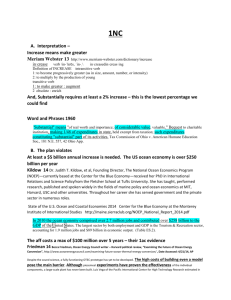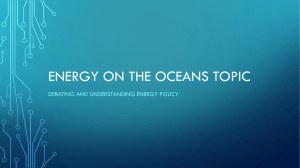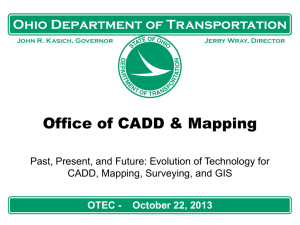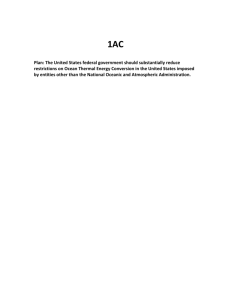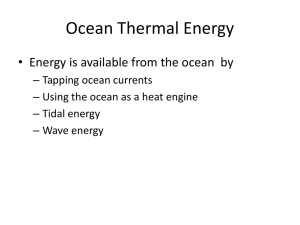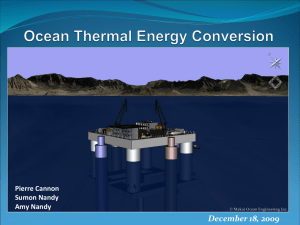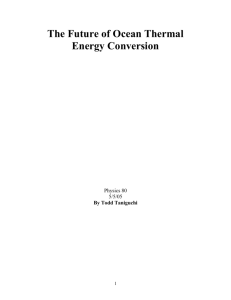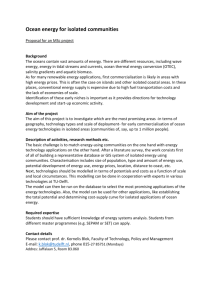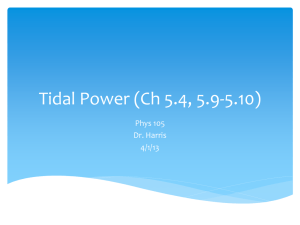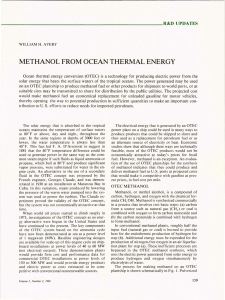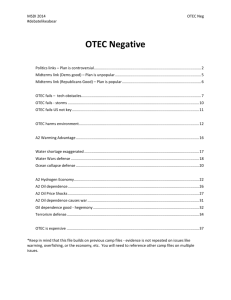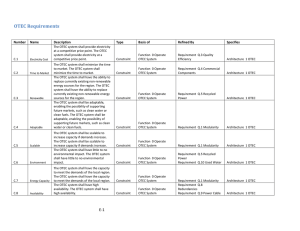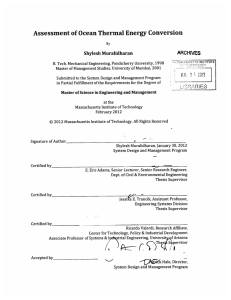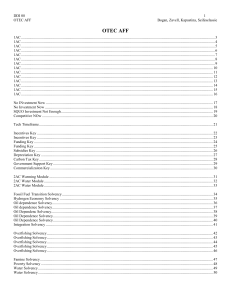New outline for OTEC
advertisement
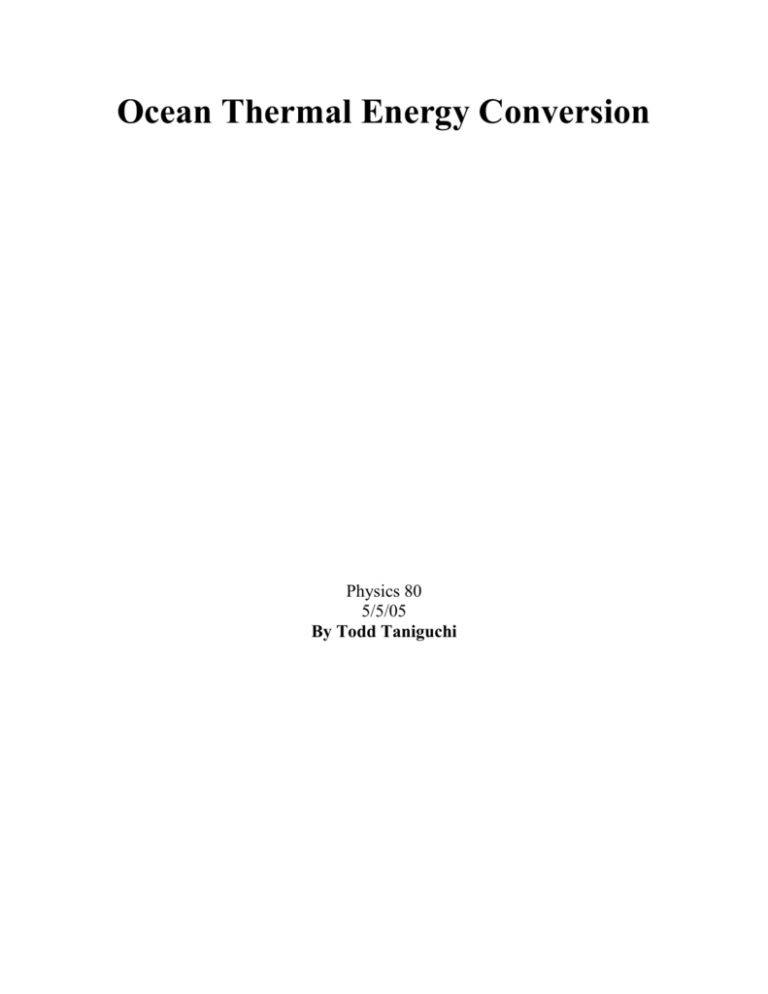
Ocean Thermal Energy Conversion Physics 80 5/5/05 By Todd Taniguchi Introduction The population of the world continues to grow. The industrialization of emerging economic powers of China and India put pressures on the worldwide demand for energy as it continues to climb. With oil prices rising while supply of oil falls, the United States’ energy portfolio must be diversified. Now, more than ever before, alternative energies have become an economic, social, and environmental necessity. The final layout of this portfolio has not yet been set. As the Nation pieces this together, the costs and benefits of different sources must be considered. One of these energy sources is Ocean Thermal Energy Conversion (OTEC). This paper will introduce the technology and attempt to determine the viability of OTEC as a part of a diversified energy portfolio for the United States. Section 1: An overview of OTEC Historical Origins: The idea of OTEC was first proposed by the French engineer Jacques D’Arsonval in 1881. D’Arsonval himself did not attempt to implement his theory, and until 1926, no attempts were made to utilize the ocean’s temperature difference. The first attempt was made by D’Arsonval’s former student, Georges Claude, who attempted to use a modified approach to D’Arsonval’s original theory. Claude failed to produce net power production in his work, but he did prove that the technology could work to produce power. The original method, proposed by D’Arsonval, is known as Closed Cycle OTEC, the second method, proposed by Claude, is known as Open-Cycle OTEC. While other methods for utilizing the temperature gradient have been hypothesized, these two types of OTEC are the best developed technologies closest to commercial feasibility. The Technology: Two Types of OTEC General Theory Although both the two types of OTEC are significantly different, an explanation of the two is best done by first describing the basics of OTEC which both have in common. With the exception of photovoltaics, all power generation systems utilize a source of mechanical energy to run a turbine. In turn, the turbine powers a generator that outputs electricity. OTEC systems are no different. OTEC utilizes a low pressure gas turbine driven by low pressure steam derived from the evaporation of the systems working fluid. Theoretical Efficiency limitations: Carnot Carnot shows that any system that produces work via thermal energy transfer from a heat source (at temperature T1) to heat sink (at temperature T2) has the following theoretical efficiency limitations: Work performed = T1 – T2, where T is measured in Kelvins Heat consumed T1 In regions near the equator, where OTEC development is generally proposed, annual average water temperatures range from 27-30˚C at the surface. At depths of about 8001000m, the temperature annually averages 4.4˚C (Avery, 126). The Carnot efficiency, then, ranges from 7.5% to at 8.1% at best. This leaves a narrow margin for energy loss since the Carnot efficiency is never attainable due to internal friction in the pipes and other thermodynamically irreversible events. In addition to this, work represents energy, not an energy rate. Optimizing any system would maximize electrical power, energy flow rate, which would not maximize work. In fact, maximizing work requires drawing power at infinitesimally slow rates. In Detail Closed Cycle OTEC (CC-OTEC) CC-OTEC systems are defined by the separation of their working fluids from the seawater that drives it. This separation allows the working fluid to be a mixture of different liquids and allows the optimization of the fluid. Although the mixtures and concentrations of working fluid for CC-OTEC systems vary, all proposed working fluids have variable boiling points, one of the major benefits of CC-OTEC systems. Thermodynamically, a variable boiling point (as opposed to a constant boiling point) increases the overall work derived from the system. For a full list of working fluids, see Table 4-1 in appendix (page 99 of Avery and Wu) Figure 1: Generalized CC-OTEC system. Notice that the working fluid is separated from the seawater and is heated/cooled at heat-exchanger interfaces. Heat Exchangers: The heat exchangers in a CC-OTEC system are vital to its performance. They are located at the separation points between the working fluid and ocean water; at the first junction, an exchanger facilitates the transfer of heat into the working fluid; at the second junction, an exchanger facilitates the transfer of heat from the working fluid into cold water. In the Kalina cycle and other new CC-OTEC designs, a third heat exchanger is used to further remove heat from the system, minimizing “waste heat”. Even lacking a deep understanding of heat engines, one should understand the importance of heat exchangers in power performance of CC-OTEC systems. The heat exchange rate is governed by the following equation: Q = UAΔT, where U is the heat transfer coefficient, A is the area of the exchanger, and ΔT is the temperature difference. The exchange rate directly impacts power production, which puts a more realistic cap on CC-OTEC energy efficiency. Efficiency Limitations—Maximizing Gross Power Production (Rankine Cycle) When maximizing power, one must consider the reductions in efficiency caused by friction and heat losses. For a CC-OTEC system, maximum power production per unit water flow “requires both a high rate of heat transfer in the heat exchangers and a large pressure difference across the turbine (Avery, 126).” The following equation, proved by Dr. Chih Wu, shows the maximum efficiency when considering gross power output: ηp = 1-(Tc/Tw)1/2 = 4.0-4.5% This figure shows the dramatic difference between the initial value allowed in the OTEC design. One of the major advantages of CC-OTEC designs are that they are viable for use on proposed “plant-ships,” floating OTEC power plants. CC-OTEC systems are required onboard plantships because size must be limited. These will be explained further in later sections. Open Cycle OTEC (OC-OTEC) OC-OTEC systems are defined by their utilization of the warm surface water as the working fluid. Therefore, the system is “Open” because the ocean water is not completely separated from the turbine (See Figure 3 below). Figure 1: An Generalized OC-OTEC: Major components of an OC-OTEC: Evaporator: Flash evaporates the warm surface water to produce steam Condenser: Turbine: Turned by the , this creates the systems electrical power Fixed gas exhaust systems: Water Pumps: Drive the in and out flows of the warm and cold water supplies Control Systems: Notice the lack of heat exchangers, a significant cost advantage. Efficiency of an OC-OTEC: η= Pn . d/dtQin where Pn is the net power and d/dtQin is the rate of heat transfer into the system (See page 213 of the book for a derivation). The efficiency of an OC-OTEC is higher because a larger portion of the temperature difference is available to produce power. In addition, it can also be used to provide drinking water. Added Benefit: Direct Fresh Water Production In addition to their potential for desalination, OC-OTEC systems produce significant amounts fresh water at the surface condenser interface(See Figure 2). This ability A Technology Not Yet Mature: OC-OTEC systems are not yet economically feasible. Research and Development of OC-OTEC systems have stalled because of problems with developing the technology on a scale large enough for the technology to be commercial. Other Applications of the Cold-Water Resources for both OC-OTEC and CCOTEC Unlike other forms of alternative energies, OTEC has the potential to facilitate the production of other useful byproducts. The figure shown below is an idealized landbased OTEC plant. Because cold seawater is naturally nutrient rich, it can be used in aquaculture to grow cold-water marine produce in tropical regions under controlled conditions. It can also be used to cool soil temperate for agriculture, stimulating the growth of plants from temperate climates. Both of these benefits would create revenue streams that could not otherwise be achieved in the tropical regions where an OTEC would be implemented. OTEC can also reduce its energy output and instead produce water via desalination. The plant could also provide air conditioning to nearby buildings, significantly reducing the grid-load. This applies mainly to island communities where hot-weather increases the demand for air-conditioning and water is scarce. Figure 3: An idealized OTEC with adjacent co-product sites. Proponents of OTEC highlight these available co-products that would help OTEC compete with more conventional energy sources. Going Out To Sea: Plant-Ship OTEC Plantship OTEC power plants have the advantage of scalability. Since land is a scarce commodity on islands and in coastal regions where an onshore. The largest proposed land-based OTEC system is 40 MWe, while the largest proposed plantship has a hypothetical power production of 400 MWe. http://www.seasolarpower.com/images/slides/Slide11.GIF Plantships, however, also come with the additional challenge of transporting produced power to the onshore pipe. There have been several proposed methods for doing this, the economics of which will be discussed briefly in section 2: Running a pipe from the offshore OTEC to the nearby land Generating hydrogen or other liquid fuels utilizing the power produced onboard and transporting it via tanker. Section 2: The Future of OTEC Although OTEC technology is not new, a commercial power plant has yet to be built. Still, however, the technology does have the ability to tap into a large source of stored solar energy. Before throwing out (or accepting!) the further development and implementation of OTEC, one should consider the barriers to commercialization, the environmental impact of its implementation, and the other available energy alternatives. Economics: An Economically Feasible OTEC? When deciding whether to approve the implementation or development of an OTEC, one factor that one should consider is the economic feasibility of the process. While considering the economic feasibility of any commodity is under scrutiny, one must consider more than the total cost of the production of the commodity: one must also consider the feasibility of substitutes for the commodity. One must also bear in mind that the main function of OTEC technology is a power plant. While co-products such as water and aquaculture products can add to the revenue generated by the facility itself, the end purpose is to replace power produced by oil with power produced by a cleaner renewable source. OTEC as a net power producing energy source The first barrier to overcome in terms of economic feasibility was the production of a net power output. This was first shown to be possible in Hawaii in 1979 with Mini-OTEC (Avery and Wu, 63). However, a net power production at a high cost per unit energy (measured in kW) relative to other energy sources is not economically feasible. Research since then has produced cycle developments in the cycles themselves and the materials used in developing the equipment. Advances in Closed-Cycle OTEC: Modified Rankine Cycles: Kalina/Uehara Cycles Improved efficiencies and decreased cost in heat exchangers Socioeconomic barriers o Political barriers Sea Solar Power: An Economically Feasible 100 MWe Plantship OTEC versus oil OTEC versus other renewable energies o Intermittency o Hydrogen production (invalidates intermittency?) o Other benefits Environmental Effects: Externalities and Additional Costs Temperature changes leading to environmental impact. The extensive affect of this may cause unknown long term effects. o The injection of cold water about 3.5˚ C above the local temperature will change salinity, nutrient distribution, mixed layer depths and sea-surface temperatures, among other things (Avery, 413). Effect on small marine life passed through the system would certainly be a concern. Although filters would be used, the system would definitely not filter all marine life or prevent damage to marine life that does not have sufficient mobility. The author is not a biologist! How would he know? In addition, many organisms could be very susceptible to small changes in salinity, temperature, etc. Pollution “Nutrient rich cold water” refers to the higher concentrations of nitrates and phosphates in the colder water. See 413-424 of the book to examine this impact. Chlorine input when using ammonia In the case of sea solar power, the working fluid is propylene. Ammonia isn’t as bad as propylene environmentally, but propylene is apparently more cost effective. Direct impact upon marine life passed through an OTEC Social/Cultural Impact Aesthetics: o Will the ship affect the residents that utilize the ocean near the plant ships location. Public opinion o Spending public money, State money in particular. Conclusion:

